Scallop fishery closure
The southern scallop fishery area (SCA 7), including Port Underwood, is closed.
More details, including a map, is in the 'closed areas and special restrictions' section of this webpage.


Recreational fishing rules for the Challenger area, including closures, restrictions, and other important notices.
The southern scallop fishery area (SCA 7), including Port Underwood, is closed.
More details, including a map, is in the 'closed areas and special restrictions' section of this webpage.
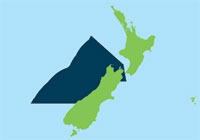
This area extends along the West Coast of the South Island north of Awarua Point, and around to Clarence Point on the east coast.
This page has the rules for:
The page has the rules for all types of recreational fishing. This includes potting, netting, and all other fishing methods.
Remember, if you're a recreational fisher, selling any fish or shellfish you catch is illegal.
You can find a summary of the size and catch limits, closed areas, and special restrictions on this page.
Size limits, catch/bag limits, closed areas, and special restrictions
You can also use the free NZ Fishing Rules app, check rules in our brochures, or text us. You'll also see signs about rules at many fishing spots.
Or free text "app" to 9889 to be sent the links to your phone. After you install it, the app will work without an internet connection.
Brochure: Recreational fishing rules – Challenger (West Area) [PDF, 1.6 MB]
Brochure: Recreational fishing rules – Challenger (East and Kahurangi) [PDF, 2.9 MB]
Visit a Fisheries New Zealand office
Send a free text to 9889 with the name of a species.
For example, text "blue cod" or "pāua" to 9889. You'll receive a text with legal bag and size limits for that species.
In the Challenger fishing area, there is a combined daily bag limit of 20 finfish* per fisher (excluding specified baitfish and freshwater eels).
This means you can have a combination of up to 20 of any finfish in total. For example, you could have 19 kahawai and 1 red cod, or 10 kahawai and 10 red cod. As long as you have no more than 20 in total.
There are also species with individual daily limits within the combined daily bag limit of 20 (Table 1). You must not exceed individual species limits. For example, there is a daily limit of 5 bluenose. This means you could have 5 bluenose and 15 kahawai.
In addition to the combined daily bag limit of 20, you can take a maximum of 50 of any combination of baitfish species (Table 3) and a maximum of 6 freshwater eels (Table 4). For example, you could take 10 kahawai, 10 red cod and 50 baitfish.
Remember, there may be other specific rules in some areas. For example, a harbour might have different size limits for certain species. Check the "Closed areas and special restrictions" section on this web page for more information.
* Finfish includes all species of finfish of the classes Agnatha, Chondrichthyes, and Osteichthyes, at any stage of their life history, whether living or dead
|
Finfish species |
Maximum daily limit per active fisher |
Min fish length (cm) |
Min net mesh size (mm) |
|---|---|---|---|
|
Blue cod Tasman – Farewell Spit to Clarence River, including Marlborough Sounds |
2* |
33 Landed whole or gutted only |
— |
|
Blue cod Westland – South Bank of Haast River to Heaphy River |
15 |
33 Landed whole, gutted or headed** and gutted |
— |
|
Blue cod Kahurangi – Heaphy River to Farewell Spit |
10 |
33 Landed whole or gutted only |
— |
|
Blue cod South West – Sandhill Point to South Bank of Haast River |
10 |
33 Landed whole or gutted only |
— |
|
Bluenose |
5 |
— |
160 |
|
Groper (Hapuku) / Bass*** |
2 |
— |
160 |
|
Kingfish |
3 |
75 |
100 |
|
Quinnat salmon |
1 |
— |
— |
|
Snapper (Challenger area) |
10 |
25 |
100 |
|
Snapper (Marlborough Sounds area) |
3 |
25 |
100 (set net bans apply) |
|
Southern bluefin tuna |
1 |
— |
100 |
|
* You can possess up to 4 blue cod in the Challenger Tasman area (includes the Marlborough Sounds area) if you can prove that no more than 2 of those blue cod were taken on any one day from the Challenger Tasman area. This restriction applies if you caught the fish from outside of the Challenger Tasman area and want to move into the Challenger Tasman area. ** Where permitted, blue cod headed state minimum length is 24cm and is measured from the base of the side pectoral fin to the middle ray of the tail fin. *** Groper (Hapuku)/Bass has an accumulation limit of no more than 3 per fisher when taken over more than one day in the Challenger area. |
|||
|
Finfish species |
Min fish length (cm) |
Min set net mesh size (mm) |
|---|---|---|
|
Blue moki |
40 |
114 |
|
Butterfish (Greenbone) |
35 |
108 |
|
Elephant fish |
— |
150 |
|
Flatfish |
25 |
100 |
|
Red cod |
25 |
100 |
|
Red gurnard |
25 |
100 |
|
Red moki |
40 |
114 |
|
Rig |
— |
150 |
|
School shark |
— |
150 |
|
Tarakihi |
25 |
100 |
|
Trevally |
25 |
100 |
|
Trumpeter |
35 |
100 |
|
All other finfish |
— |
100 |
| Baitfish species | Maximum daily limit per active fisher |
|---|---|
|
Anchovy |
Daily limit of 50 for any combination of these species |
|
Jack/Horse/Chilean mackerel |
|
|
Koheru/Scad |
|
|
Pilchard |
|
|
Piper/Garfish |
|
|
Slender/Stout sprat |
|
|
Yellow-eyed mullet |
| Finfish species | Maximum daily limit per active fisher | Min mesh size (mm) |
|---|---|---|
|
Eel |
6 |
12 |
Shellfish are considered "taken" (collected or harvested) when they cannot freely return to the water. For example, when you put them in a bag. When you're gathering or collecting, you can never possess more than your daily limit.
Remember, there may be other specific rules in some areas. For example, a harbour might have different size limits for certain species. Check the "Closed areas and restrictions" section on this page for more information.
|
Shellfish Species |
Daily limit per fisher |
Min size (mm) |
|---|---|---|
|
Cockles |
150 |
none |
|
Kina (sea eggs) |
50 |
none |
|
Mussels |
50 |
none |
|
Oysters |
|
|
|
Pāua |
|
|
|
Pipi |
150 |
none |
|
Scallops* † |
50 |
90 |
|
Toheroa |
Prohibited |
Prohibited |
|
Tuatua |
150 |
none |
|
All others (combined) • |
50 |
none |
* A diver on a boat can gather extra bag limits of oysters and scallops for up to 2 other people who are ensuring dive safety on the boat.
*** Map for the Nelson and Marlborough pāua restriction [PDF, 1.3 MB]
**** Map of the Marfells Beach to Conway River Area [PDF, 58 KB]
† Since 15 July 2018, the Marlborough Sounds, Tasman Bay, Golden Bay, and Port Underwood are closed to scallop fishing until further notice.
• This is a combined, mixed-species bag limit. It applies to all shellfish species not specifically named above and includes all crabs, limpets, starfish, periwinkles, whelks, barnacles, and freshwater crayfish (koura).
This section has the rules for both:
Remember, there may be other specific rules in some areas. Check the "Closed areas and special restrictions" section on this page for more information.
Rules changing in CRA5 area from 1 July 2020
Maximum of 6 rock lobster (both species combined) per day.
| Lobster species | Tail width measurement |
| Red or spiny rock lobster (crayfish) |
Male – 54 mm Female – 60 mm |
| Packhorse rock lobster |
Male – 84 mm Female – 90 mm |
If you are unsure of the sex, use the female (larger) measurement.
Learn how to measure rock lobster and identify the sex:
Rock lobster (crayfish): rules and guidelines
There are rules for gathering rock lobster/crayfish that cover:
Some types of rock lobster are protected. You must return them to the water straight away. Protected rock lobsters are:
Visit our rock lobster page for information on pot construction and use
Telson clipping is required for all spiny rock lobsters that you take.
The last third of the telson (central part of the tail fan) must be cut off so that it is noticeably shorter than the other sections of the tail fan.
Labelled diagram of a telson-clipped lobster [PDF, 551 KB]
Do not telson clip any packhorse rock lobsters.
When daily limits are accumulated over a multi-day trip, the maximum number of spiny rock lobster that one person can have in their possession at any one time is 18 spiny rock lobsters (3 daily bag limits of 6).
This possession limit applies everywhere, including in the home.
"Bag and tag" conditions apply – you must hold spiny rock lobster in a container or bag that contains only a single day’s catch and is clearly labelled with:
Insert iframe title here
Transcript - show/hide
00:02 Hi team, my name is Gary McAneny, I'm a senior compliance officer based in mount
00:08 Maunganui. You should be able to see it over my shoulder.
00:10 You've probably guessed what we're all about here judging by this little
00:13 character here. This is all about telson clipping for rock lobster
00:17 come the first of july 2020 we're now obliged in
00:20 in cray 2 and cray 5. Hauraki Gulf, Bay of Plenty,
00:25 Marlborough and Canterbury to clip the tails
00:29 on recreationally caught rock lobsters so
00:32 I'm going to talk about that today the reason that we're doing that is to make
00:37 the recreationally caught rock lobsters different from the commercial rock
00:42 lobsters and that's going to deter poaching it's
00:45 it's a it's probably a part of our toolbox of measures that help us
00:51 help us to go some way to limit the amount of poaching that goes on
00:56 and it's hopefully the general public can assist us
00:59 by doing this small thing and essentially it is clipping one
01:06 third of the length of the telson which is the centre fin on a rock
01:12 lobster tail as you can see here we've got them all
01:14 spread out there i'm going to go about doing it for you now
01:18 it's it's a simple matter you take your dive knife pair of scissors
01:21 either way you've got to take that last third of the telson off
01:26 no more and no less let's get that done right there it is that's done now that's
01:32 a legal recreationally caught rock lobster when you come ashore now
01:36 that has to be done immediately as soon as you take this rock lobster
01:40 you need to do this you can't do it under the water we're accepting that but
01:43 obviously when you get back to the boat you take your tank off the first thing
01:47 you do open your catch bag pull the rope
01:50 lobster out inspect it for size condition berry and
01:55 the crays that you're going to keep you cut the
01:59 telson back by one third you don't do that for pack horse rock
02:04 lobster you only do that for spiny red rock lobster
02:07 and that helps us to recognise the fish that should
02:11 or shouldn't be in the commercial industry the crays that are in the
02:15 commercial side will all be complete the crayfish that are
02:18 recreationally taken will need to have the telson clip that's us
The lists below show areas where:
You can't fish in these areas. This includes marine reserves.
Marine reserves are managed by the Department of Conservation (DOC).
A to Z of marine reserves – DOC
Find out more about the Southern Scallop Fishery and Port Underwood closure
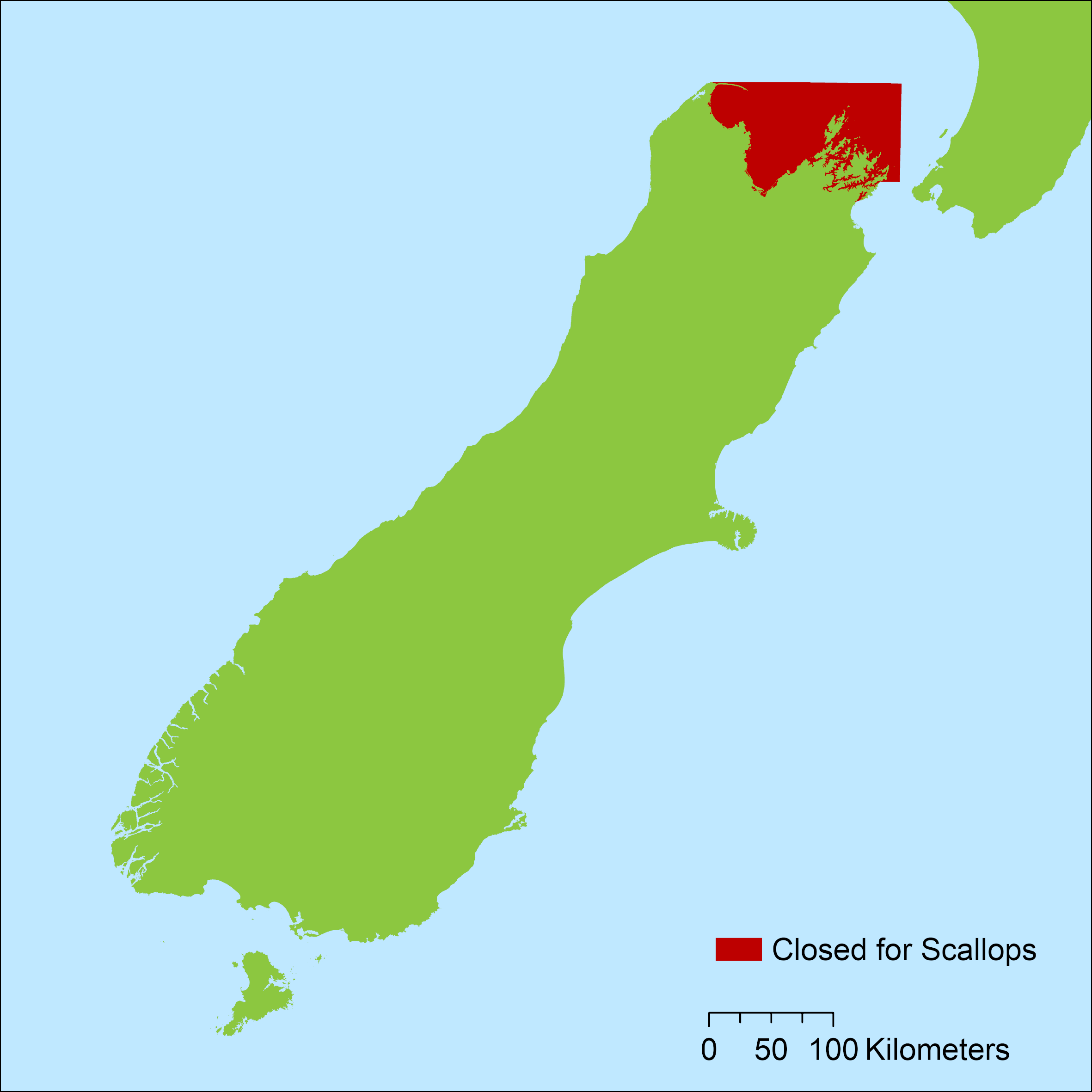
Set netting is banned from Farewell Spit to Cape Soucis, then from Cape Jackson to the Clarence River out to 4 nautical miles. This includes:
Find out about the new restrictions
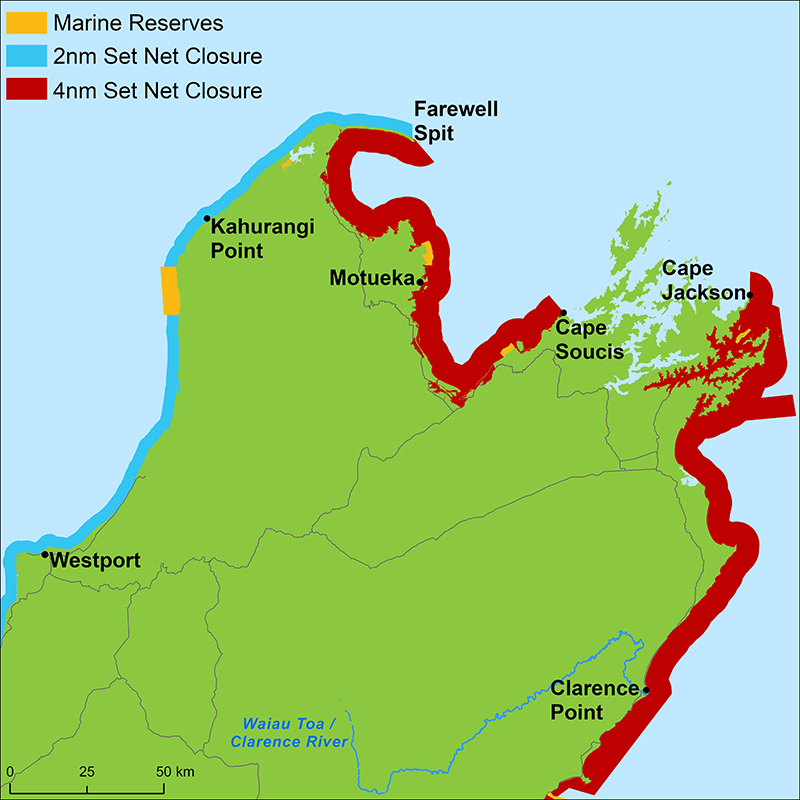
Set netting is banned on the West Coast, from Farewell Spit to Awarua Point. The ban area extends from the shore out to 2 nautical miles.
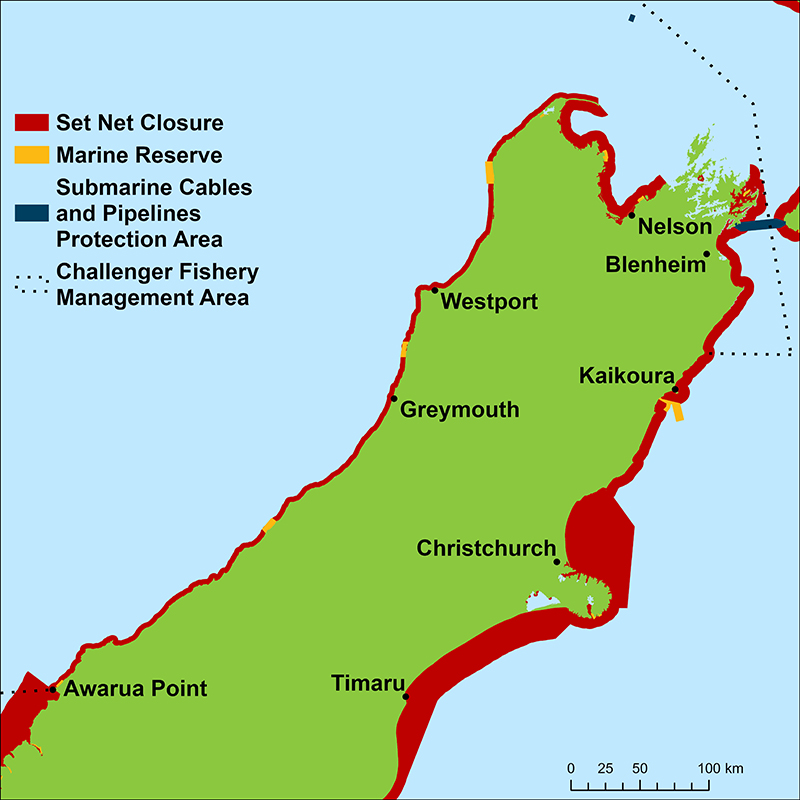
For the area between Marfells Beach (west of Cape Campbell) and the Conway River (which sits south of the Kaikōura township), extending 4 nautical miles from shore, the following will apply.
The Kaikōura pāua fishery (Marfells Beach to Conway River) is now closed. If you take any pāua from this area you face prosecution.
Recreational fishers will be able to take other shellfish and seaweed (except Bull kelp) in this area from 22 April 2024 onwards according to the limits set in the Fisheries (Recreational Management Controls) Notice (April 2023).
|
(Pāua season) |
Blackfoot pāua |
Yellowfoot pāua |
|---|---|---|
|
Marfells Beach to Conway River |
No take - The Kaikōura pāua fishery is now closed |
|
|
Oaro-Haumuri Taiāpure |
||
There are some areas that remain closed to all seaweed and shellfish (except kina) gathering during and after the pāua season.
The Oaro-Haumuri Taiāpure will be open to pāua gathering during the open season according to the limits in the table above, but will be closed to seaweed and shellfish (except kina) gathering outside the pāua season.
The Hikurangi Marine Reserve and Waiopuka (Wakatu Quay) reef area are closed to all fishing at all times.

The marine environment in the shellfish and seaweed closure area is damaged after the earthquakes, and it’s going to take several years to recover. The loss of fishing grounds between North Canterbury (Conway River) and Marlborough (Marfells Beach) has caused an increase in fishing pressure on the neighbouring areas.
If you are gathering kaimoana in Marlborough and Canterbury, do your part to help keep these fisheries sustainable by:
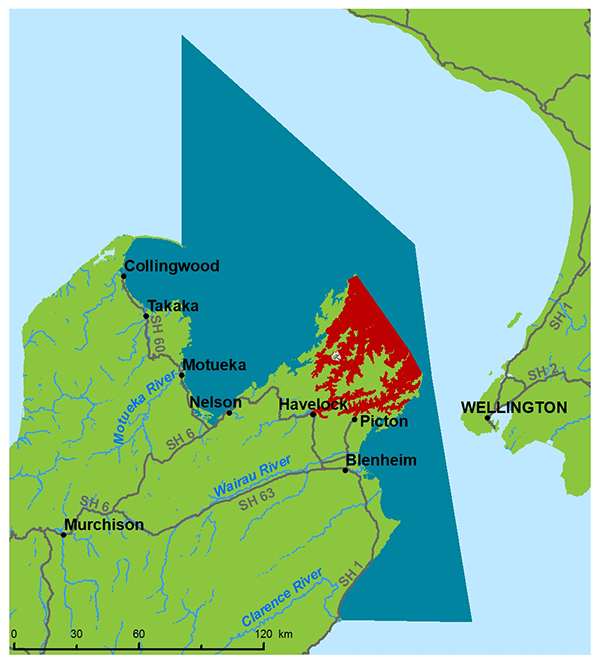
Find out more about the Southern Scallop Fishery and Port Underwood closure
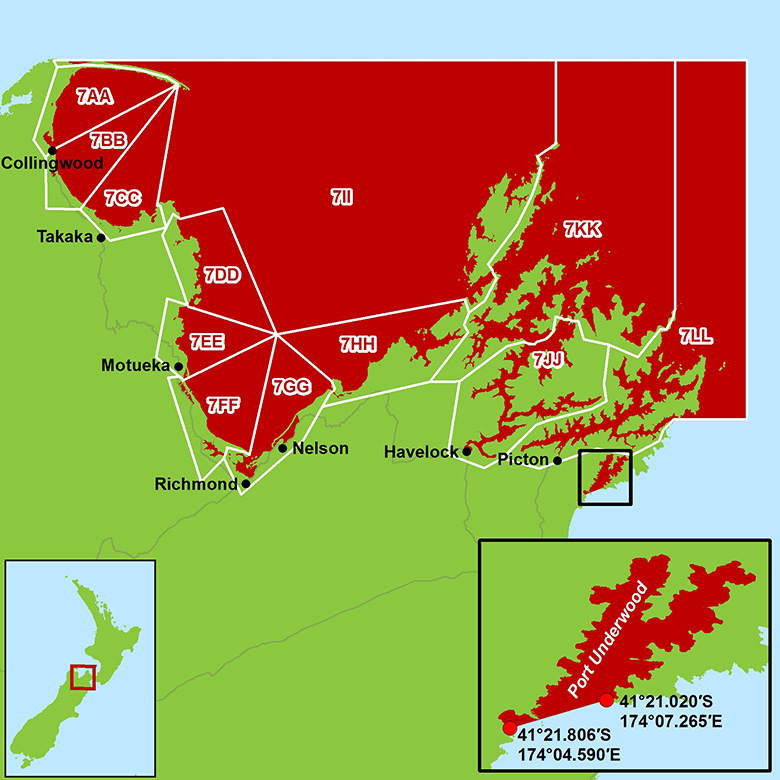
Particular fishing methods are banned or catch/bag limits for particular species are different.
|
Restriction |
Rule |
|---|---|
|
Pot construction |
Rigid square mesh, where:
|
|
Accumulation limit |
When your fishing trip is more than one day, if you can prove you have not taken more than the daily bag limit on any given day you can possess 2 daily bag limits of blue cod. |
|
Closed season |
The Marlborough Sounds area is closed to blue cod fishing from 1 September to 19 December each year. |
|
Measurable state |
|
|
Eating blue cod on the boat |
|
|
Within the Challenger Westland blue cod management area (Haast River to Heaphy River |
Blue cod can be landed whole or gutted, or headed and gutted (with the pectoral fins still attached). Headed state minimum length is 24cm, measured from the base of the side pectoral fin to the middle ray of the tail fin. |
We issue warnings not to collect shellfish when testing shows that they contain unsafe levels of toxins.
You can report poaching, suspicious, or illegal activity online:
Report illegal fishing (such as poaching)
You can also:
You can help us by providing:
When reporting any suspected poaching put your personal safety first. All calls and personal details are treated as confidential.
These are offences against the Fisheries Act which can result in fines up to $250,000.
Our regional Facebook pages bring you information about the fishing rules and how we manage and protect local fisheries:
Fisheries (Amateur Fishing) Regulations 2013 – NZ Legislation
If you have questions about Challenger area fishing rules, email info@mpi.govt.nz






MPI uses cookies to improve your experience on our site. By using our website, you accept our use of cookies.
